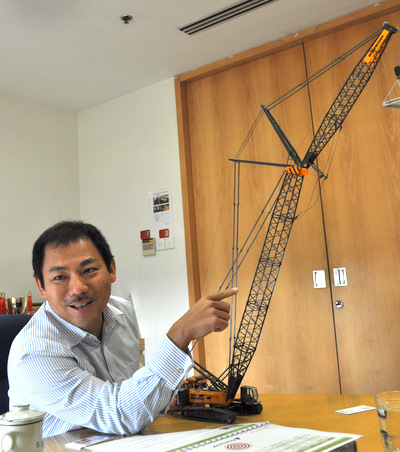'Greenrookie' is an avid investor who posts his views frequently in various forums. Clearly, he is not that 'green' an investor.
I COMPARED 3 construction companies --Tiong Seng, Chip Eng Seng and Lian Beng.
Note that construction companies are divided into 2 main categories -- building and civil engineering.
Of the three, Tiong Seng has focused more on civil engineering projects through joint ventures.
Chip Eng Seng and Lian Beng heavily rely on building construction.
My view is that investors hoping that these 2 companies can get a pie of the upcoming MRT building projects shouldn’t keep their hopes too high. They do not have a strong track record in securing such work nor civil engineering contracts.
After comparing the three companies, I decided to invest in Chip Eng Seng (CES).

Reasons:
- All three rely heavily on building construction projects, but CES gets the bulk of the construction contracts from HDB, which is on a major building programme. A check of GEbiz will show 7 HDB tenders each for the month of September and October. CES has a long working relationship with HDB and has thus far been able to win many HDB contracts.
In the earlier years, when CES was newly listed, more than 90% of its contracts came from HDB. Lian Beng and Tiong Seng, however, are stronger at private projects, so with the property-market cooling measures aimed at private sector, I am afraid the pie might shrink going forward. -
In terms of construction capabilities, Tiong Seng looks most promising, with first mover advantage in green building construction. It has won many awards from the Building & Construction Authority (BCA) which recognizes its capabilities in green building construction, productivity, etc.
 Tiong Seng Holdings CEO Pek Lian Guan. Nextinsight file photo
Tiong Seng Holdings CEO Pek Lian Guan. Nextinsight file photo
Its order book of $1.4 billion as of 31 Dec 2011 and new project awards worth another 500 million since then, speak volumes about its clients’ confidence in the company.
However, the problem is its property development arm, which is still small in terms of revenue contribution and is mainly focused on China.
We all know about China’s curbs on its property sector and a closer look at the Q1 and Q2 reports on Tiong Seng’s China property development will show that the commencement of construction of its Suzhou project was delayed from Q2 to Q4, phase 2 sales of Equinox was also delayed from Q2 to Q3, and now to Q4. The property curbs do have an impact on its PRC property development.
- Dividend yield: CES has been giving out dividends since its listing and the yield is high. The record 4 cents per share translates into an 8.5 % yield. If the dividend is lowered to 3 cents, it’s still a good 6.3% yield, higher than Lian Beng’s and Tiong Seng’s.
Also, although the dividend per share paid out was at a record high, the payout ratio was low, at 15%, and 21% of earnings in 2011 and 2012, respectively. Prior to these 2 years, the payout ratio ranged from 32% to 65%. This speaks of the sustainability of dividends as long as property development arm holds up.
- CES has highly visible earnings from property development. Its 33M project is already fully sold and will be recognized in 2013, while Prive and Belysa (both 40% ownership) and My Matthantan will TOP in 2013. Belysa is already 86.9% sold, will TOP in 2014, followed by Fulcrum, most probably in 2015. At soft launch, Tower Melbourne was 56.5% sold.
CES will also build a hotel in the Alexandra area, and that will most probably be ready in 2015. The land parcel at Perth is still pending development, and has room for growth with low land cost. - In terms of valuation, CES, Lian Beng and Tiong Seng are trading at 0.74, 0.86, 0.77 P/B. CES has the biggest proportion of property in development, yet it is trading at the lowest in terms of P/B ratio.
- We all know construction is a low margin business, that’s why construction companies are going into the property development business. CES has the largest property contribution, by percentage, to its revenue and profits. In terms of construction margins, Lian Beng beats CES, while CES relies on the bulk of its construction contracts from HDB, while Lian Beng’s comes from the private sector, where the margin is higher.
That is why when construction costs escalated in 2008, CES was making a loss in its construction division, whereas Lian Beng managed a 7% margin. But when it comes to property development, CES outshines Lian Beng. -
Lian Beng also derives revenue from concrete mixing whereas CES has a business in precasting.
 Lian Beng Group executive chairman Ong Pang Aik.
Lian Beng Group executive chairman Ong Pang Aik.
NextInsight file photo.
Lian Beng’s property development is still small relative to its overall revenue and profits (around 10%), although it is still growing, CES, on the other hand, has been in this business since 2000, and has fared rather well recently in Australia. (Land cost is low, but at prime area- CBD), and property development forms a big portion of profits at 40%.
Risks:
- CES has become more and more of a property developer than a construction company, and will be badly affected if the property sector is hit (think cooling measures and interest rate hikes). As a property developer, it is a small player and does not have a big landbank.
- Both construction and property development are highly competitive businesses, and CES is hardly in a dominant position, with razor-thin margins for its construction of HDB flats.
- The Australian market, while not as risky as China’s, is still subject to risks. CES didn’t update investors on its Vietnam venture, which I believe has gone to the dogs.
- Construction costs remain high, and looking at the estimated construction costs from the BCA website, construction costs in 2011 and 2012 were dangerously close to that of the year 2008 end and 2009, where CES just broke even in its construction business. Going forward, I believe margins for the construction business will be in the low single digits.
Recent stories:
LIAN BENG: 1Q2013 Numbers Fall On Delayed Recognition Of Industrial Project
TIONG SENG HOLDINGS: Record $1.4 Billion Orderbook, Highest Among Listed Contractors








For CES,33M is already being recognise in this current q3 reporting.
not very profitable.